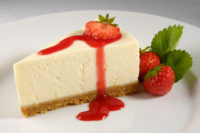
Reaching For The Stars
by Julie Cook Ramirez
As yogurt’s fortunes climb, cottage cheese’s struggles appear far from over,
while dip-makers seek to expand use of their products.
Quite possibly the greatest
crossover success from the health-food store to the mainstream supermarket,
yogurt’s popularity among American consumers continues to grow.
In recent years, yogurt makers have significantly
boosted yogurt’s consumption through a variety of initiatives and
R&D efforts designed to encourage yogurt-eating at just about any time
of time, as a dessert or between-meal snacks. They’ve also developed
a thriving kids’ consumer base, thanks largely to innovative
products, such as Yoplait’s Go-Gurt, Dannon’s Danimals and
Stonyfield Farms’ YoBaby.
As a result, sales have risen year after year. During
the 52-week period ending June 18, 2006, sales of yogurt in supermarkets,
drugstores and mass merchandisers, excluding Wal-Mart, rose 5.3 percent in
dollars and 4.6 percent in units, according to Chicago-based Information
Resources Inc. (IRI).
The seemingly unstoppable nature of yogurt’s
comes as no surprise to Ron Schroder, director of marketing, Swiss Valley
Farms, Davenport, Iowa. He points to the product’s numerous positive
attributes. “Yogurt is ideally positioned for today’s
consumer needs,” he says. “It’s got fantastic health
benefits, it’s convenient and it’s portable.”
| TOP 10 INDIVIDUAL YOGURT/YOGURT DRINK BRANDS* | ||||||
| $ Sales (In Millions) |
% Change vs. Year Ago |
Dollar Share |
Unit Sales (In Millions) |
% Change vs. Year Ago |
||
| Total Category | $3,078.5 | 5.3% | 100.0% | 3,484.5 | 4.6% | |
| Refrigerated Yogurt (Cup) | 2,640.3 | 4.8 | 85.8 | 3,254.7 | 4.0 | |
| Refrigerated Yogurt Drinks | 438.2 | 8.3 | 14.2 | 229.9 | 13.3 | |
| Private Label | 362.2 | 3.3 | 11.8 | 639.2 | 3.0 | |
| Yoplait Original | 341.2 | 11.4 | 11.1 | 506.8 | 7.9 | |
| Yoplait Light | 251.9 | 26.1 | 8.2 | 396.3 | 25.4 | |
| Dannon Light n Fit | 211.5 | 15.7 | 6.9 | 260.0 | 11.9 | |
| Stonyfield Farm | 116.5 | 22.1 | 3.8 | 89.6 | 17.1 | |
| Yoplait Go-Gurt | 104.1 | -15.3 | 3.4 | 37.2 | -18.7 | |
| Dannon Danimals | 100.5 | 1.8 | 3.3 | 36.6 | -3.1 | |
| Yoplait Whips | 94.4 | 15.7 | 3.1 | 153.7 | 17.2 | |
| Yoplait Trix | 85.5 | -7.0 | 2.8 | 33.5 | -7.1 | |
| Dannon Fruit on the Bottom | 81.1 | -1.6 | 2.6 | 135.0 | -2.4 | |
| * Total sales in supermarkets, drug stores and mass merchandisers, excluding Wal-Mart, for the 52-week period ending June 18, 2006. SOURCE: Information Resources Inc. | ||||||
It’s the health benefits of yogurt which are
front and center these days, as processors have embraced the trend toward
so-called “functional yogurts,” specifically those yogurts
which offer added benefits beyond the standard calcium, protein and live
and active cultures.
Kyle Duea, marketing manager for Yoplait USA Inc., the
Minneapolis-based subsidiary of General Mills Inc., agrees that added
health benefits are currently one of the major focuses of the category,
although he argues that “all yogurt could be described as
functional.”
Widely available throughout Europe for two decades,
functional yogurts have only recently begun showing up on American shores.
Introduced initially in France in 1987, Dannon’s Activia contains
billions of beneficial cultures, including the company’s proprietary
Bifidus Regularis. According to Andreas Ostermayr, vice president of
marketing, The Dannon Co., White Plains, N.Y., Activia is clinically proven
to help regulate the digestive system in just two weeks, when eaten on a
daily basis.
Recognizing the importance of digestive health,
Antioch, Calif.-based Brown Cow Farm recently introduced Brown Cow Low Fat
Yogurt with Fruit & Whole Grains. The mix of lowfat yogurt, real fruit,
whole grains and sunflower and flax seeds also features a unique live,
active culture blend of S. thermophilus, L. bulgaricus, L. acidophilus, and Bifidus, widely
considered to be beneficial in digestion.
Meanwhile, CoolBrands International unveiled Breyers
Light Probiotic Plus Yogurt, containing Bifidobacterium cultures, which
have been shown to help maintain the balance of bacteria in the intestine.
According to Matt Smith, vice president of marketing, it’s all about
giving consumers what they want. “Consumers’ demand for healthy
yogurt goes beyond just vitamins and nutritious ingredients,” he
explains. “It also includes health benefits like aiding in
digestion.”
Likewise, Swiss Valley Farms rolled out new and
improved versions of its lowfat and light yogurts, both containing inulin,
an emerging source of fiber derived from the chicory root. Containing 100
calories, the light variety is fat free with no sugar added, another
attribute which keeps popping up in the yogurt category. Introduced at the
end of 2005, for example, Dannon’s reformulated Light ‘n Fit
nonfat yogurt is sweetened with Splenda. Meanwhile Londonderry, N.H.-based
Stonyfield Farm uses erthritol — an all-natural, no-calorie
alternative — in the company’s light yogurt line.
While a number of no-sugar-added yogurts are now
available, Miriam Erickson Brown, president and chief executive officer of
Anderson-Erickson Dairy Co., Des Moines, Iowa., balks at the suggestion of
producing a kid-oriented sugar-free product.
“We don’t want to ruin the appeal of yogurt
for kids by taking out what they like,” she says. “I would
rather have them get a little sugar and get all the nutrients of yogurt,
rather than picking up a nutrient-empty alternative snack product.”
Stonyfield Farm boosted the nutritional value of its
kids’ line late last year, unveiling YoBaby Plus Fruit & Cereal
with DHA, an omega-3 fatty acid considered an essential building block for
optimal brain and eye development in babies and toddlers. In Hayward,
Calif., Omega Farms, a subsidiary of Pacific Cheese, sells four varieties
of yogurt — plain, peach, strawberry, and vanilla — all
containing 75 milligrams of EPA/DHA omega-3 fatty acids. According to Cindy
DiFerdinand, corporate nutritionist and director of sales, dairy products
are the ideal carrier for the fatty acids.
In Canada, Dannon unveiled Cardiva fat-free yogurt with
omega-3 fatty acids. Asked whether we can expect to see the product in U.S.
supermarkets anytime soon, Ostermayr is tight-lipped: “We are not at
liberty to speculate about product introductions before they’re
announced.”
Considering yogurt’s popularity and the potential
windfall that a successful new product introduction could produce, the
majority of yogurt processors are not about to tip their hand with regard
to ongoing R&D efforts. It’s easy to justify investments in
R&D when a category has enjoyed such long-term growth, however.
“The sky is the limit with yogurt,” Brown
says. “When you have a category that’s growing like that, the
sky’s the limit. The possibilities are endless.”
Trying Times
Unfortunately, not all cultured products have enjoyed
the same kind of seemingly non-stop growth as yogurt. Take cottage cheese,
for example. The ailing category’s struggles continued this past
year, as hopes of any kind of lasting positive impact from the low-carb
craze were all but dashed. According to IRI, dollar sales of cottage cheese
fell 2.2 percent and unit sales fell 1.8 percent during the 52-week period
ending June 18, 2006.
“It fascinates me that the low-carb craze
wasn’t that trigger that all of a sudden led to a doubling of cottage
cheese demand,” says Jed Davis, director of marketing, Cabot Creamery
Cooperative, Cabot, Vt. “The fact that it wasn’t makes me more
concerned that this is by no means going to be an easy category to ring out
even high single-percentage growth on a broad market basis.”
In an action that symbolically hammered the final nail
in the low-carb coffin, Le Mars, Iowa-based Wells’ Dairy Inc.
discontinued its Blue Bunny Carb Freedom Cottage Cheese. Not everyone is
convinced that the low-carb craze failed to provide a boost to cottage
cheese, however. Brown claims that low-carb dieting “brought a huge
awareness” to the category which continues to this day. In
particular, she says, the craze brought younger consumers to the category,
as they sought out low-carb, high-protein foods.
Anyone who’s been following the category in
recent years is well aware that the aging cottage-cheese consumer is of
paramount concern. While marketers bat around ideas of how to entice
younger consumers — particularly children — to the category,
processors say it’s hard to justify any significant investment in
R&D when demand is so low.
There are exceptions, however. Faced with the choice of
whether to invest in new cottage cheese-making equipment or get out of the
category altogether, Cabot took a chance and installed a new closed-vat
system in a special room dedicated to cottage cheese production. According
to Davis, the new system not only allows Cabot to produce a more
consistent, high-quality product, but it also opens the door to future
innovation, including flavored cottage cheese.
“We’ve always kept half-an-eye on flavored
cottage cheese, but we just weren’t in a position where we could
consider that type of product, given manufacturing constraints” he
says. “We’re hopeful the new equipment will provide some
opportunities for us to look at opportunities that our cottage
cheese-making facility just didn’t support before.”
| TOP 10 INDIVIDUAL COTTAGE CHEESE BRANDS* | ||||||
| $ Sales (In Millions) |
% Change vs. Year Ago |
Dollar Share |
Unit Sales (In Millions) |
% Change vs. Year Ago |
||
| Total Category | $847.8 | -2.2% | 100.0% | 406.2 | -1.8% | |
| Private Label | 303.8 | -2.4 | 35.8 | 156.1 | -2.8 | |
| Breakstone | 86.2 | 2.2 | 10.2 | 32.9 | 1.3 | |
| Knudsen | 72.9 | -3.6 | 8.6 | 27.0 | -4.2 | |
| Breakstone Cottage Doubles | 33.5 | 16.9 | 3.9 | 31.2 | 19.2 | |
| Dean’s | 28.1 | 1.7 | 3.3 | 12.4 | 1.3 | |
| Friendship | 27.5 | -0.5 | 3.2 | 13.5 | 2.0 | |
| Hood | 22.7 | 0.4 | 2.7 | 10.1 | -2.0 | |
| Prairie Farms | 17.4 | -8.9 | 2.1 | 8.3 | -7.2 | |
| Light ‘n Lively | 16.0 | -9.0 | 1.9 | 6.1 | -9.4 | |
| Knudsen Cottage Doubles | 12.9 | 23.6 | 1.5 | 10.4 | 27.5 | |
| * Total sales in supermarkets, drug stores and mass merchandisers, excluding Wal-Mart, for the 52-week period ending June 18, 2006. SOURCE: Information Resources Inc. |
||||||
Even if Cabot does embark on a flurry of new product
development, Davis says the company remains somewhat handcuffed by high
slotting fees that make product introductions prohibitively expensive,
particularly in a stagnant category like cottage cheese.
“We’re confident we can make a really
dynamite flavored cottage cheese,” Davis says. “It’s just
a matter of whether we can foresee adequate sales to make the payoff on
some of these slotting fees be appropriate.”
At least Cabot is now in the position to physically
produce new varieties of cottage cheese. Other dairies simply don’t
have that luxury. Brown says a variety of cottage cheese innovations are on
her “wish list,” but the company’s production is simply
not set up for such endeavors at this time.
Meanwhile, Swiss Valley was experiencing success with
its single-serve 1% cottage cheese, introduced in fall 2004, but changes in
the company’s production plant eliminated its ability to produce that
particular offering.
Despite numerous challenges, processors remain hopeful
that cottage cheese will someday reap the same kinds of rich rewards as
yogurt. Remarks Davis: “It’s so hard not to point to
yogurt’s success and say, ‘Et tu, cottage cheese?’”
Expanding Usage
While cottage-cheese makers are free to dream of kids
begging their parents to buy their product, dip makers would be happy just
to see more of a year-round trend in sales. Because dip is largely viewed
as a special-occasion product, processors say they experience definite
spikes at certain times of the year, such as Christmas, the Fourth of July
and Super Bowl Sunday.
| TOP 10 INDIVIDUAL SOUR CREAM BRANDS* | ||||||
| $ Sales (In Millions) |
% Change vs. Year Ago |
Dollar Share |
Unit Sales (In Millions) |
% Change vs. Year Ago |
||
| Total Category | $679.6 | -2.0% | 100.0% | 437.2 | -1.5% | |
| Private Label | 194.7 | -4.4 | 28.5 | 148.6 | -3.1 | |
| Daisy | 142.5 | 15.0 | 21.0 | 80.4 | 16.3 | |
| Breakstone | 100.7 | -4.4 | 14.8 | 67.6 | -2.8 | |
| Daisy | 50.6 | -1.5 | 7.5 | 23.0 | 2.3 | |
| Knudsen Hampshire | 13.8 | 2.3 | 2.0 | 11.4 | 5.1 | |
| Daisy Light | 12.2 | 3.2 | 1.8 | 3.4 | 4.3 | |
| Friendship | 10.9 | 1.2 | 1.6 | 5.4 | 4.5 | |
| Knudsen | 9.1 | -6.3 | 1.3 | 6.0 | -4.5 | |
| Cacique | 8.2 | -7.0 | 1.2 | 4.7 | -9.7 | |
| Dean’s | 6.9 | -11.5 | 1.0 | 4.9 | -11.3 | |
| * Total sales in supermarkets, drug stores and mass merchandisers, excluding Wal-Mart, for the 52-week period ending June 18, 2006.SOURCE: Information Resources Inc. | ||||||
Not content with the number of holidays for which
consumers purchase dip, Heluva Good LLC, a Sodus, N.Y.-based subsidiary of
Chelsea, Mass.-based HP Hood LLC., has taken to pushing
“non-traditional holidays,” like Halloween, according to Jay
Snedeker, general manager and vice president of sales.
“Halloween becomes a bigger and bigger holiday
every year,” Snedeker says. “They don’t get the day off,
but a whole bunch of people party on Halloween. Raising that awareness
level and timing our promotions to fit in with the Halloween timeframe has
been pretty successful for us.”
Anderson-Erickson, meanwhile, views those spikes as
opportunities to expose more consumers to their products by increasing
their sales efforts and tailoring their marketing messages to convey the
wide variety of dips available. That includes their newest dip variety,
French Onion Garlic, an offering Brown says has actually resulted in
“love letters” from consumers. In raving about the product,
consumers describe the many ways in which they are using it, including
making “awesome mashed potatoes.” According to Brown,
that’s not unusual, as consumers frequently recount using their dips
in “non-traditional ways” — on sandwiches or burgers, for
example.
| TOP 10 individual refrigerated DIP BRANDS* | ||||||
| $ Sales (In Millions) |
% Change vs. Year Ago |
Dollar Share |
Unit Sales (In Millions) |
% Change vs. Year Ago |
||
| Total Category | $403.5 | 0.7% | 100.0% | 183.9 | -3.0% | |
| T. Marzetti | 80.9 | 0.9 | 20.1 | 26.5 | -0.5 | |
| Private Label | 79.6 | 10.8 | 19.7 | 40.3 | -0.5 | |
| Dean’s | 45.1 | -5.2 | 11.2 | 26.1 | -4.8 | |
| Heluva Good | 30.3 | 2.4 | 7.5 | 16.2 | 6.2 | |
| Kraft | 24.8 | -9.8 | 6.1 | 15.7 | -8.7 | |
| Classic Guacamole | 17.3 | 2.2 | 4.3 | 4.3 | -1.4 | |
| Calavo | 7.0 | 64.4 | 1.7 | 1.8 | 63.0 | |
| Litehouse | 5.3 | 12.0 | 1.3 | 2.1 | 6.7 | |
| Salads of the Sea | 4.9 | -2.7 | 1.2 | 1.4 | -10.6 | |
| Bison | 4.3 | -6.1 | 1.1 | 2.6 | -6.6 | |
| * Total sales in supermarkets, drug stores and mass merchandisers, excluding Wal-Mart, for the 52-week period ending June 18, 2006. SOURCE: Information Resources Inc. |
||||||
Versatility is at the heart of marketing efforts for
IncreDiples, a line of lowfat, yogurt-based snack dips from Wells’
Dairy. Marketed as a vegetable/cracker/wing dip, salad dressing, sandwich
spread or recipe ingredient, IncreDiples have proven so successful that
Wells already has several new flavors “on the drawing board,”
according to Troy Davis, Wells’ marketing manager for retail dairy.
Citing the growth in the Hispanic food market, Pete
Kondrup, general manager of Westby County Creamery, Westby, Wis., says his
company has a Jalapeño Cheddar dip in the works that could possibly
hit store shelves later this year. Swiss Valley has already experienced
success with a new Hispanic-oriented flavor, Chipotle Ranch, as well as a
new Garden Vegetable variety. And, recognizing that consumers frequently
buy a tub of dip, use it once or twice, and then throw out the remainder
once the use-by date passes, Swiss Valley has converted its entire dip line
from 16-ounce to 8-ounce tubs.
“Taking down the size not only makes it more
convenient from a usage standpoint, but it also takes the price point
down,” Schroder says. “Our everyday price point on dips is now
99 cents, which is a fairly low barrier to trial or purchase.”
Dip makers say consumers would be more open to trying
refrigerated dips if they were merchandised near popular carriers, like
chips or crackers. While Kondrup says he’s seen some stores place
small refrigerated cases of dip in the snack aisle, he concedes
that’s a prohibitively expensive undertaking for many retailers. That
said, dip makers would still like to see more favorable placement of their
products.
“From a merchandising standpoint, there’s
something really compelling about being able to be right there,” says
Cabot’s Davis. “In the politics of the dry grocery department,
too often there is refrigerated grocery and there’s dry grocery and
never the twain shall meet — or at least we haven’t seen as
much marrying between the two as we would like.”
$OMN_arttitle="Reaching For The Stars";?>



